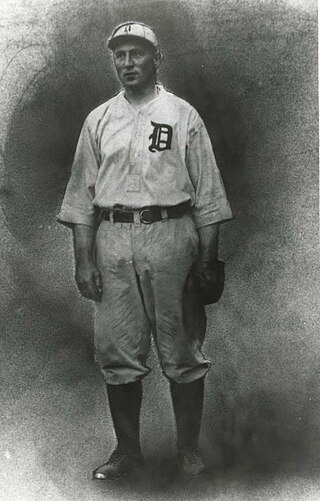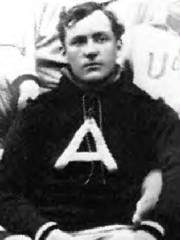Related Research Articles

Charles Morrison Robinson, most commonly known as Charles M. Robinson, was an American architect. He worked in Altoona and Pittsburgh, Pennsylvania from 1889 to 1906 and in Richmond, Virginia from 1906 until the time of his death in 1932. He is most remembered as a prolific designer of educational buildings in Virginia, including public schools in Richmond and throughout Virginia, and university buildings for James Madison University, College of William and Mary, Radford University, Virginia State University, University of Mary Washington, and the University of Richmond. He was also the public school architect of the Richmond Public Schools from 1910 to 1929. Many of his works have been listed on the National Register of Historic Places.

John Franklin Eubank, nicknamed "Honest John," was a right-handed pitcher in Major League Baseball who played for the Detroit Tigers from 1905 to 1907.

Eli Abbott was an American football player and coach of football and baseball. He played college football at the University of Alabama and the University of Pennsylvania and coached the Alabama Crimson Tide football team from 1893 to 1895 and again in 1902.

Milton Parker Scott, nicknamed "Mikado Milt", was an American professional baseball player whose career spanned from 1882 to 1889. He appeared in 341 Major League Baseball games over four seasons as a first baseman for the Chicago White Stockings, Detroit Wolverines, Pittsburgh Alleghenys and Baltimore Orioles. He compiled a .228 batting average with 42 doubles, 10 triples, five home runs, and 132 RBIs.
William Francis Knox was an American football player and coach and lawyer. He played college football for Yale University and was selected as a first-team All-American halfback in 1906. He was the head coach of the 1907 Yale football team which finished the season with a record of 9–0–1. He later became an attorney and was a founder and member of the Pittsburgh law firm of Moorhead & Knox.

Ulysses J. Lincoln Peoples was an American architect based in Pittsburgh, Pennsylvania. Five schools located in Pittsburgh, Pennsylvania that were designed by Peoples have listed on the National Register of Historic Places.

Joseph Franklin Kuntz was an American architect who was based in Pittsburgh, Pennsylvania. He designed at least eighteen armories in Western Pennsylvania, with the W.G. Wilkins Company, following the 1905 creation of a state armory board.
John "Jack" Oughton was a skilled stonemason in Lincoln County, Idaho. A number of his works are listed on the U.S. National Register of Historic Places.

Benjamin Detwiler Price was an architect known principally for his catalogue sales of plans for churches. He reportedly sold over 6,000 copies of his church plans, and several of the churches he designed are listed on the United States National Register of Historic Places.
William Lindsey Darrah was a sheep rancher and stonemason in Shoshone, Idaho known for his construction of lava rock water tanks from the 1910s to 1920s. He built water tanks ranging from approximately eight to 30 feet high and from 12 to 25 feet in diameter. His tanks were typically built with a stone foundation several feet into the ground. The walls were approximately three feet wide and built out of lava stones and lime mortar. Darrah's tanks were typically accompanied by one-story pump houses
Walter Mickle Smith, Sr. was a civil engineer who worked primarily on U.S. dams and waterway projects. He was a consulting engineer on the construction of the Panama Canal and Panama Canal Locks and later served as design engineer for the New York Board of Water Supply. He spent much of his career with the State of Illinois waterways division and was its chief engineer until his retirement in 1937. Several of his works built in the 1920s and 1930s as part of the Illinois Waterway project are listed on the National Register of Historic Places, including portions of the Brandon Road Lock and Dam, the Dresden Island Lock and Dam, the Lockport Lock and Power House, and the Marseilles Lock and Dam.
Orlo Epps was an American architect, mathematician, physicist, and socialist writer.

Alfred Ellet Hitchner was an American football player, coach, electrical engineer and businessman. He was the head coach of the Rutgers Scarlet Knights football team in 1904. He later worked for many years for Westinghouse Electric Company in Pennsylvania and California.

Charles Henry Thompson served as chief justice of the Illinois Supreme Court in 1945, 1946, 1949, and 1950 after being elected to the Illinois Supreme Court in 1942. He was born on December 11, 1882 near Mount Vernon, Posey County, Indiana to Lewis Thompson, a farmer, and his wife Emma Monroe Thompson. In 1884, he and his family moved to Harrisburg in Saline County, Illinois. By 1910, his father had begun mining coal, and Charles was working as a bookkeeper in the coal office. In 1914, Charles married Ethel K. Knight of Harrisburg.

The American Sheet and Tin Mill Apartment Building, one of the Edison Concept Houses, is a historic building at 633 West 4th Avenue in Gary, Indiana. The building was designed by D. F. Creighton and built in 1910. It was added to the National Register of Historic Places on June 17, 2009. It was built by the United States Sheet & Tin Plate Co.

Jackson–Monroe Terraces Historic District is a national historic district located in the First Subdivision of Gary, Indiana. The district encompasses 30 contributing buildings in a residential section of Gary. The buildings were designed by D. F. Creighton and built by the United States Sheet & Tin Plate Co. They were built starting in 1910 and are examples of the Edison Concept Houses that were designed, patented, and promoted by inventor Thomas Edison. The houses reflect Bungalow / American Craftsman design elements.

Monroe Terrace Historic District is a national historic district located in the First Subdivision of Gary, Indiana, United States. The district encompasses eight contributing buildings in a residential section of Gary. The buildings were designed by D. F. Creighton and built by the United States Sheet & Tin Plate Co. They were built starting in 1910 and are examples of the Edison Concept Houses that were designed, patented, and promoted by inventor Thomas Edison. The houses reflect Bungalow / American Craftsman design elements.

Polk Street Terraces Historic District is a national historic district located in the First Subdivision of Gary, Indiana. The district encompasses 20 contributing buildings in a residential section of Gary. The buildings were designed by D. F. Creighton and built by the United States Sheet & Tin Plate Co. They were built starting in 1910 and are examples of the Edison Concept Houses that were designed, patented, and promoted by inventor Thomas Edison. The houses reflect Bungalow / American Craftsman design elements.

Polk Street Concrete Cottage Historic District is a national historic district located in the First Subdivision of Gary, Indiana. The district encompasses four contributing buildings in a residential section of Gary. The buildings were designed by D. F. Creighton and built by the United States Sheet & Tin Plate Co. They were built starting in 1910 and are examples of the Edison Concept Houses that were designed, patented, and promoted by inventor Thomas Edison. The houses reflect Bungalow / American Craftsman design elements.

Van Buren Terrace Historic District is a national historic district located in the First Subdivision of Gary, Indiana. The district encompasses 10 contributing buildings in a residential section of Gary. The buildings were designed by D. F. Creighton and built by the United States Sheet & Tin Plate Co. They were built starting in 1910 and are examples of the Edison Concept Houses that were designed, patented, and promoted by inventor Thomas Edison. The houses reflect Bungalow / American Craftsman design elements.
References
- 1 2 Christopher Baas. "USDI/NPS NRHP Multiple Property Documentation: Concrete in Steel City: The Edison Concept Houses of Gary Indiana" (PDF). Archived from the original (PDF) on 2017-02-11. Retrieved 2012-09-29.
- 1 2 Charles Vinz (December 11, 2008). "The Sheet and Tin Plate Company Edison Concept Houses of Gary, Indiana". Proximity: Contemporary Art & Culture.
- ↑ Census entry for David Creighton. 1880 U.S. Census. Census Place: Allegheny, Allegheny, Pennsylvania; Roll: 1086; Family History Film: 1255086; Page: 105C; Enumeration District: 005; Image: 0213. (The 1880 Census lists a David Creighton, age 22, born in Pennsylvania, living as a boarder at a house in Allegheny, Pennsylvania. His occupation was listed as a carpenter.)
- ↑ Census entry for David F. Creighton. 1900 U.S. Census. Census Place: Allegheny Ward 3, Allegheny, Pennsylvania; Roll: 1355; Page: 10B; Enumeration District: 22; FHL microfilm: 1241355. (The 1900 Census has an entry for David F. Creighton, a Pennsylvania native born March 1858, living in Allegheny, Pennsylvania. His wife was identified as Amanda Creighton. They were living with Amanda's parents Robert and Mary Adair. David's occupation was listed as a "Mechanical Engineer.")
- 1 2 Census entry for D. F. Creighton. 1910 U.S. Census. Census Place: Harmony, Beaver, Pennsylvania; Roll: T624_1310; Page: 16A; Enumeration District: 0031; Image: 512; FHL microfilm: 1375323. (The 1910 Census has an entry for a D. F. Creighton, a Pennsylvania native living in Harmony Township, Beaver County, Pennsylvania. He was 51 years old and living with his wife Amanda A. His occupation was listed as a "Mechanical Engineer" for a "Sheet & Tin Plate Co.")
- ↑ Census entry for David F. Creighton. Ancestry.com. Pennsylvania 1910 Miracode Index [database on-line]. (The Pennsylvania 1910 Miracode Index shows a D. F. Creighton, age 51, a Pennsylvania native, living in Ambridge, Pennsylvania (also in Beaver County) with a wife named Amanda A.)
- ↑ City directories for Gary, Indiana in the years 1911, 1913, 1918, and 1920 list a David F. Creighton. The 1918 and 1920 directories list his wife as Amanda A. Creighton. The directories identify him as an architect (1911 and 1913), manager construction department (1918), or engineer (1920).
- ↑ Census entry for David Creighton. 1920 U.S. Census. Census Place: Gary Ward 2, Lake, Indiana; Roll: T625_446; Page: 2A; Enumeration District: 98; Image: 305. (The 1920 Census has an entry for David Creighton, age 58, born in Pennsylvania. His occupation is listed as an engineer at a sheet & tin mill. His wife is identified as Amanda. Address is same as in city directories: 712 Tyler, Gary, Indiana.)
- ↑ Census entry for David Creighton. 1930 U.S. Census. Census Place: Avalon, Allegheny, Pennsylvania; Roll: 1959; Page: 24B; Enumeration District: 493; Image: 932.0; FHL microfilm: 2341693. (The 1930 Census lists a David F. Creighton, age 69, Pennsylvania native, living in Avalon Borough in Allegheny County, Pennsylvania, with his wife Amanda. His occupation is listed as an "engineer steel" in the "architectural" field. They were living with Amanda's sister, Margaret M. Adair.)
- ↑ Find A Grave lists an Amanda Adair Creighton (1860-1936), wife of David F. Creighton. Find A Grave. It also lists a David F. Creigton, died Nov. 30, 1936 (10 months after Amanda). Find A Grave. Both are buried at Union Dale Cemetery, Pittsburgh.
- 1 2 3 4 5 6 "National Register Information System". National Register of Historic Places . National Park Service. July 9, 2010.
- ↑ "NRHP Registration Form For American Sheet and Tin Mill Apartment Building" (PDF). Indiana Department of Natural Resources, Division of Historic Preservation & Archaeology.
- ↑ "NRHP Registration Form For Jackson-Monroe Terraces Historic District" (PDF). Indiana Department of Natural Resources, Division of Historic Preservation & Archaeology.
- ↑ "NRHP Registration Form For Polk Street Terraces Historic District" (PDF). Indiana Department of Natural Resources, Division of Historic Preservation & Archaeology. Archived from the original (PDF) on 2010-08-24. Retrieved 2012-09-29.



